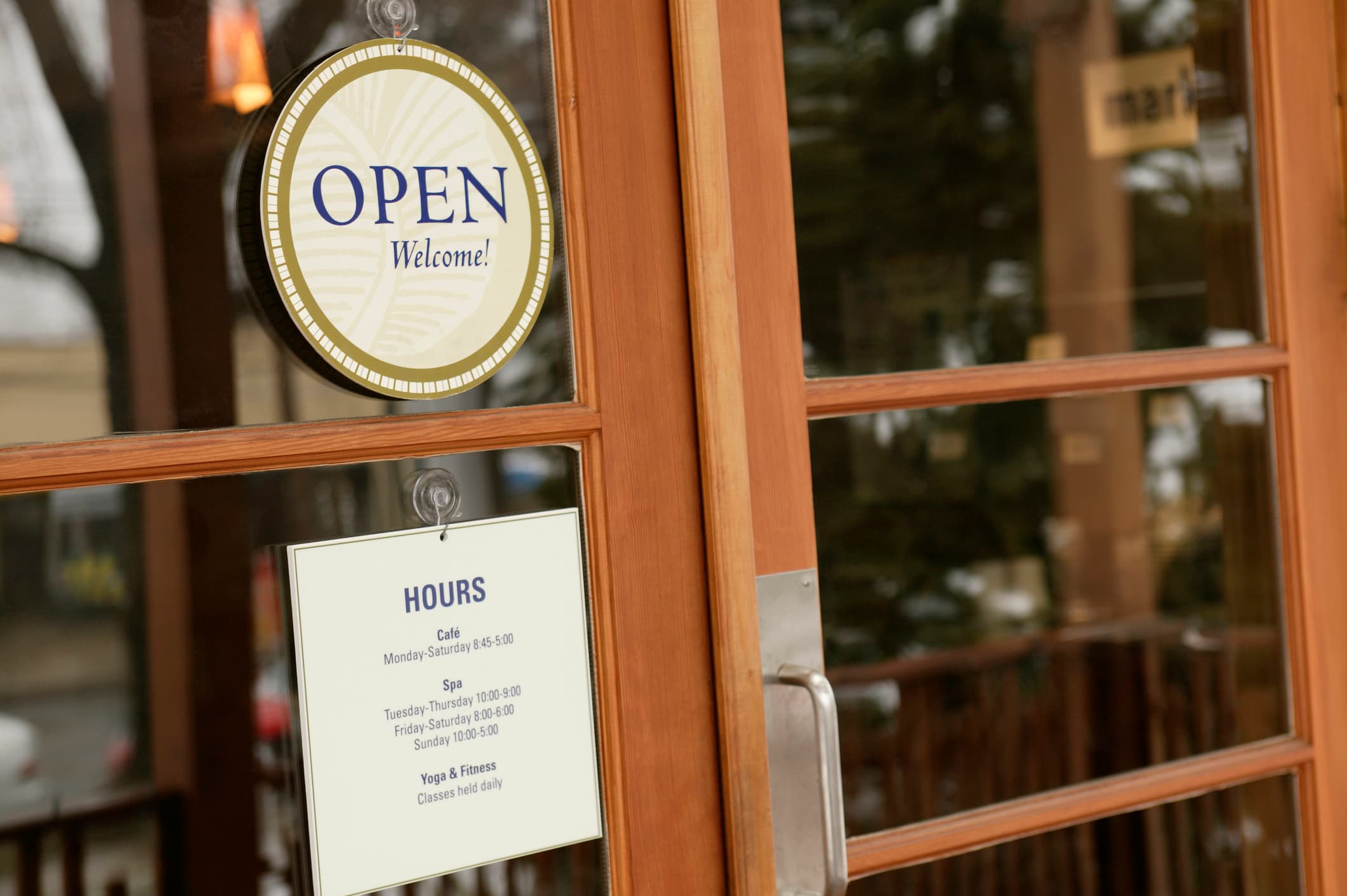MENU
Start
- Best Small Business Loans for 2024
- Businessloans.com Review
- Biz2Credit Review
- SBG Funding Review
- Rapid Finance Review
Our Recommendations
- 26 Great Business Ideas for Entrepreneurs
- Startup Costs: How Much Cash Will You Need?
- How to Get a Bank Loan for Your Small Business
- Articles of Incorporation: What New Business Owners Should Know
- How to Choose the Best Legal Structure for Your Business
Our Guides
- Business Ideas
- Business Plans
- Startup Basics
- Startup Funding
- Franchising
- Success Stories
- Entrepreneurs
Small Business Resources
Grow
- The Best Credit Card Processors of 2024
- Clover Credit Card Processing Review
- Merchant One Review
- Stax Review
Our Recommendations
- How to Conduct a Market Analysis for Your Business
- Local Marketing Strategies for Success
- Tips for Hiring a Marketing Company
- Benefits of CRM Systems
- 10 Employee Recruitment Strategies for Success
Our Guides
- Sales & Marketing
- Finances
- Your Team
- Technology
- Social Media
- Security
Small Business Resources
Lead
- Best Business Phone Systems of 2024
- The Best PEOs of 2024
- RingCentral Review
- Nextiva Review
- Ooma Review
Our Recommendations
- Guide to Developing a Training Program for New Employees
- How Does 401(k) Matching Work for Employers?
- Why You Need to Create a Fantastic Workplace Culture
- 16 Cool Job Perks That Keep Employees Happy
- 7 Project Management Styles
Our Guides
- Leadership
- Women in Business
- Managing
- Strategy
- Personal Growth
Small Business Resources
Find
- Best Accounting Software and Invoice Generators of 2024
- Best Payroll Services for 2024
- Best POS Systems for 2024
- Best CRM Software of 2024
- Best Call Centers and Answering Services for Busineses for 2024
Our Recommendations

Online only.
Table of Contents
Lending money is risky, which is why lenders often protect their investments with liens. Liens are legal filings that allow lenders to claim property if the borrower defaults on repayment. If you’ve secured a business loan through a lien and can’t meet your monthly payments — and the lender has tried to settle the debt — the assets you’ve put up as collateral may be sold.
We’ll explain more about liens, their risks, how they can help your business and how to get rid of them.
Editor’s note: Looking for a business loan? Fill out the below questionnaire to be connected with vendors that can help.
What is a lien, and how does it work?
Liens give lenders a legal claim or right to property or assets you own because you owe them money. Lenders keep this claim until you pay down your debt.
“Liens secure a financial obligation,” said Stuart Wolfe, a lawyer who represents banks with the firm Wolfe & Wyman. “A lien can’t exist without an obligation. If you pay off the financial obligation on a traditional mortgage on your house, the mortgage or deal of trust goes away because it has nothing to secure.”
Liens can be placed on real estate, equipment or pretty much any other type of valuable personal property. “‘Personal property’ might sound like it refers to real estate, but it’s a legal term that refers to equipment, vehicles, jewelry, furniture and any other things a person can own,” said Jane Muir, an attorney at J. Muir & Associates who specializes in commercial litigation, contracts and general counsel.
The most important thing to note about liens is that they are legally binding. In the event of a default, the lender will claim whatever property it has liens on to cover the loan. Different types of liens can be invoked in various scenarios, but when it comes to small business loans, the lender and borrower agree on the lien. In most instances, liens secure your loan in the event of a default, which drives down your interest rate.
“The less security or liens you give the lender, the more you’re going to pay as a borrower on the loan,” Wolfe noted. “You’re generally not going to find real financing opportunities where there’s zero liens.”
Before signing a loan contract, you should review the agreement with an attorney or an experienced business owner to ensure you understand the loan terms, interest rate and other transaction details.
What are the types of liens?
Loan nonrepayment is a common issue that can result in liens being placed on your assets. Here are some kinds of liens you may encounter:
1. Tax lien
This lien is placed on your assets when you don’t pay your taxes. It’s one of the ways the Internal Revenue Service collects unpaid taxes; the federal, state or local government takes a security interest in your property or real estate. Remember, you must pay your tax debt before your mortgage.
2. Consensual liens
When you take out a loan and put up an asset as collateral, you consent to having a lien put on your property. This is a standard option you’ll see with bank loans.
“It occurs when you agree to give the lender an interest from what you owe as security,” said Timo Wilson, CEO of Asapfundr Inc. “For example, when you buy a house and you take a mortgage, you’re giving the lender a voluntary lien since there’s an added interest to the actual price of it.”
3. Judgment lien
Judgment liens are usually the result of a lawsuit. If you fail to repay your debt, a court ruling gives a creditor, lender or lienholder the legal right to take possession of your personal property. This is an involuntary lien, meaning it doesn’t require your consent.
4. Mechanic’s lien
Although a mechanic’s lien is a more industry-specific lien, it’s important to know how it works. In this case, contractors are typically the lienholders. When you don’t pay for work done on your property — such as your home, office or warehouse — you can be hit with a mechanic’s lien. Let’s say a general contractor does work on your property, but you fail to pay them — the contractor can then have a lien placed on your property.
Tax liens can devastate a business. Failing to get your business taxes in order can lead to tax liens, levies, wage garnishment and other repercussions.
How can liens help your business?
Liens help drive down the debtor’s interest rate. Providing property to offset a loan’s risk assures the lender that it will recoup its money, even if you default. This assurance allows the lender to charge you lower interest, making it more affordable for your business to borrow money to finance specific projects or purchases.
“If a business needed equipment to expand, a bank might extend a loan to purchase the equipment, and the loan would be secured by a lien,” Muir explained. “The money the business earns from the use of the new equipment pays off the loan over time, instead of having to pay one lump sum for the expansion.”
It’s unwise to try to place multiple liens from various banks on one asset. Lenders will likely look unfavorably on “encumbered property” and not agree to the terms. However, according to Muir, multiple liens can end up on the same piece of collateral if a lender doesn’t thoroughly scrutinize a business’s financial history.
Depending on your business’s financial situation and available collateral, lenders may still charge high interest rates. However, generally, business collateral and liens can help lenders get more favorable loans.
What are the risks of liens?
As with any significant financial decision, it’s crucial to understand your loan agreement risks. Consider the following when you’re evaluating lien risks:
1. Understand what assets are at stake with your lien.
When it comes to asset-based lending, ensure you clearly understand what assets the lender will place liens on. For example, if you default and there’s a lien on your home, it could be devastating.
“Just like any debt, it is important to weigh the risk and understand that defaulting on the loan could be an expensive choice,” Muir said.
2. Determine if a personal guarantee is required.
Personal guarantee clauses are another risk area to understand. Personal guarantees are legally binding agreements that say you will personally pay back the loan if your business can’t make its payments. While personal guarantees differ from liens, lenders can still establish liens through personal guarantees.
Wolfe offered an example. Say a business takes out a loan with a lender. The lender places a lien on a business asset, and the business owner signs a personal guarantee. In this case, the business owner may be required to accept another lien on personal assets to secure their business’s loan in the event of default. If the business defaults on the loan and its collateral doesn’t cover it, the lienholder can then liquidate the business owner’s personal assets on which it holds liens to cover the loan.
The best business loans provide a straightforward application process, competitive interest rates and terms, and reasonably fast funding.
How do you get rid of a lien?
It is crucial to understand how to eliminate a lien and its legal claims against your assets. Here are some ways to remove a lien:
- Pay off your debt in full. When you pay down what you owe, a lien is no longer needed. “At that point, a ‘release of lien’ will be issued, which should be signed at the time of final payment as proof that this payment was made, as well as to serve as an assurance that no judgment will be placed against the property,” explained Anna Barker, personal finance expert and founder of LogicalDollar.
- Ask the court to remove a judgment lien. After you request this, it is up to the court to approve your appeal to eliminate the lien. The status of your debt determines this decision.
- File for bankruptcy. Filing for bankruptcy is also an option because it bypasses whatever decisions were made in state court. However, this should be your last resort. You can work with a bankruptcy attorney to help you file for Chapter 7 and extinguish your lien. However, only some liens, such as judicial liens, qualify for Chapter 7. These liens may also be enforceable for a short period rather than permanently.
Liens are one — but not the only — way to secure funding
There are several ways to finance your business, and each has its own risk level. To get a traditional loan, you must provide extensive financial information, put up collateral and adhere to lengthy reporting requirements. You can also explore other financing methods, including the following:
Another option is to seek funding from angel investors. “If you are in a high-risk business, consider inviting investment rather than incurring debt,” Muir advised. “Investors accept certain risks that lenders do not accept, and if there is a possibility of default, it may be preferable to share the risk with others.”
Max Freedman and Matt D’Angelo contributed to this article. Source interviews were conducted for a previous version of this article.


















